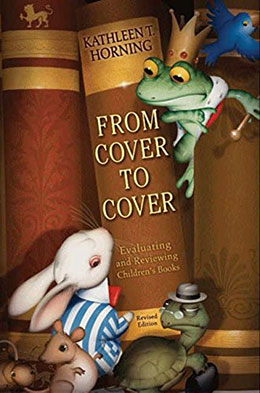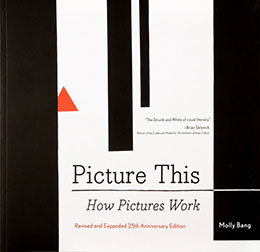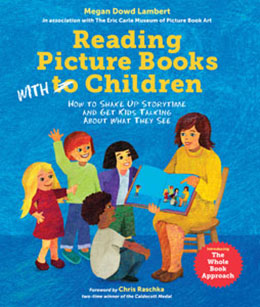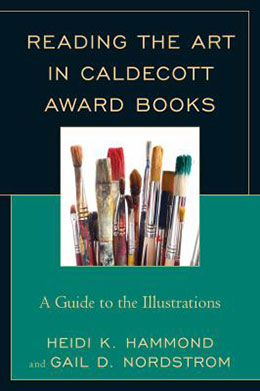This column focuses on thematic connections among Caldecott Award books, but this month we are introducing some books about illustration. In picture books, the illustrations often carry half, or more than half, of the narrative. Increased understanding of illustration techniques can enhance your appreciation and pleasure when reading and sharing picture books. Some of these books are entertaining to read from beginning to end. Others are handy references to dip into on occasion.
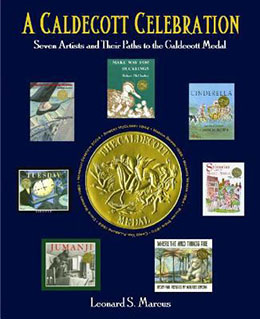
Caldecott Celebration:
Seven Artists and their Paths
to the Caldecott Medal
Leonard Marcus
Walker & Company, 2008
Caldecott Medal winners from seven decades are presented in the book Marcus wrote to celebrate the 70th anniversary of the prestigious award. Learn how popular artists Robert McCloskey, Marcia Brown, Maurice Sendak, William Steig, Chris Van Allsburg, David Wiesner, and Mordicai Gerstein create their illustrations through personal anecdotes and visits to their studios. An introduction provides historical information about the Caldecott Award.
From Cover to Cover:
Evaluating and Reviewing Children’s Books
Kathleen T. Horning
HarperCollins, revised edition, 2010
Considered a definitive resource for evaluating and reviewing children’s literature, this book contains a chapter on picture books. Within that chapter, Horning analyzes texts and illustrations in several picture books. A discussion of visual elements, composition, media, and style are presented with examples from exemplary books. In addition to criteria for evaluation, a brief history of picture books introduces the chapter.
A Picture Book Primer:
Understanding and Using Picture Books
Denise I. Matulka
Libraries Unlimited, 2008
After defining picture books and providing a history of the format, Matulka delves into the “Anatomy of a Picture Book.” This accessible handbook helps educators and librarians better understand how picture books work, introducing paratext, composition, design, elements of art, style, and medium, with black and white drawings to illustrate the concepts presented. The book includes an extensive glossary of picture book terms.
Picture This: How Pictures Work
Molly Bang
Chronicle Books, 2019
The 2016 25th anniversary edition of Bang’s classic work is the third rendition of her 1991 examination of the emotional impact of images. Using geometric shapes and limited color to illustrate scenes from “Little Red Riding Hood,” the author-illustrator explores and explains the power of design. Later, she outlines her twelve principles of art and composition. This revision includes an in-depth study of the emotion that drives four illustrations from Bang’s Caldecott Honor book When Sophie Gets Angry — Very, Very Angry….
Reading Picture Books with Children:
How to Shake up Storytime and
Get Kids Talking about What They See
Megan Dowd Lambert
Charlesbridge, 2015
Lambert describes her Whole Book Approach to sharing picture books with children, developed during her experience leading storytime programs at the Eric Carle Museum of Picture Book Art in Massachusetts. This child-driven technique goes far beyond reading stories, encouraging active participation of the young audience through open-ended questions and prompts well before the narrative begins. Children consider such features as trim size, cover, endpapers, typography, and page design. The full-color handbook concludes with sample questions for group leaders, as well as a glossary of book and storytime terminology.
Reading the Art in
Caldecott Award Books:
A Guide to the Illustrations
Heidi Hammond and Gail Nordstrom
Rowman & Littlefield, 2014
This is a handbook to be used in conjunction with selected Caldecott Award books. Artistic analyses of the illustrations will help those who share books with children to discuss the artwork for which the books won the award. Styles, media, composition, and design are also presented. Useful components of the book include a glossary of art terms and indexes of author-illustrator-title, media, and style.
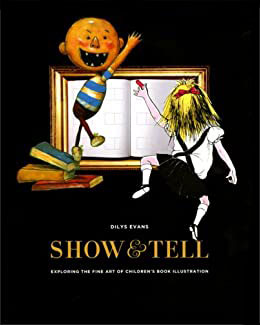
Show and Tell:
Exploring the Fine Art
of Children’s Book Illustration
Dilys Evans
Chronicle Books, 2008
Evans examines the works of twelve accomplished picture book illustrators — many Caldecott award winners — including Bryan Collier, Denise Fleming, Brian Selznick, and David Wiesner. Each chapter includes a brief biography of the featured creator, including their early art experiences and artists who have influenced their work, and a close study of full-color illustrations from a number of his or her notable titles.
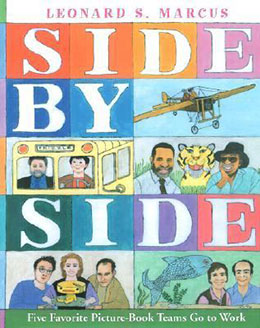
Side by Side:
Five Favorite Picture-Book Teams Go to Work
Leonard Marcus
Walker & Company, 2001
Marcus describes the collaboration and creative process of writing and illustrating picture books with five teams: Julius Lester and Jerry Pinkney, Joanna Cole and Bruce Degen, Arthur Yorinks and Richard Egielski, Alice and Martin Provensen, and Jon Scieszka, Lane Smith, and Molly Leach. The chapters generally focus on writing and illustrating one book. Thumbnail sketches, dummy books, and finished work are included as well as manuscript notes. Some personal information about the authors and illustrators may also be of interest.
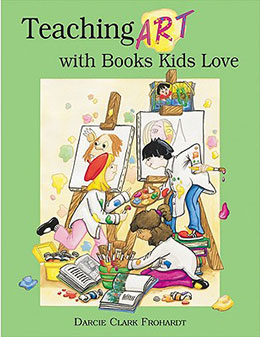
Teaching Art with Books Kids Love
Art Elements, Appreciation
and Design with Award-winning Books
Darcie Clark Frohardt
Fulcrum, 1999
This book is organized into three parts: elements of art, principles of design, and artistic style. Within each part, Frohardt defines the concept, lists fine art and children’s literature examples, and then demonstrates how an award-winning artist used the concept in a particular book.This is followed with various activities children can attempt for their own exploration of the concept. While not comprehensive, the book introduces basic information appropriate for an elementary audience.
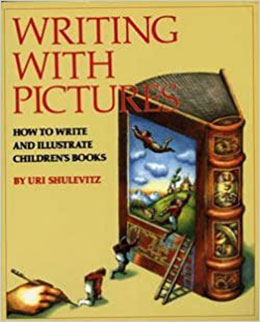
Writing with Pictures:
How to Write and Illustrate Children’s Books
Uri Shulevitz
Watson-Guptill, 1997
In this classic work geared to aspiring children’s book creators and aficionados, renowned author-illustrator Shulevitz studies the picture book, considering the story, structure, and illustrations. Hundreds of black, white, and red images fill the hefty tome, describing the visual principles covered. Note that with leaps in book printing technology in recent years, the concluding section, “Preparing for Reproduction,” now provides a historical view of 20th century book printing, especially color pre-separation.

